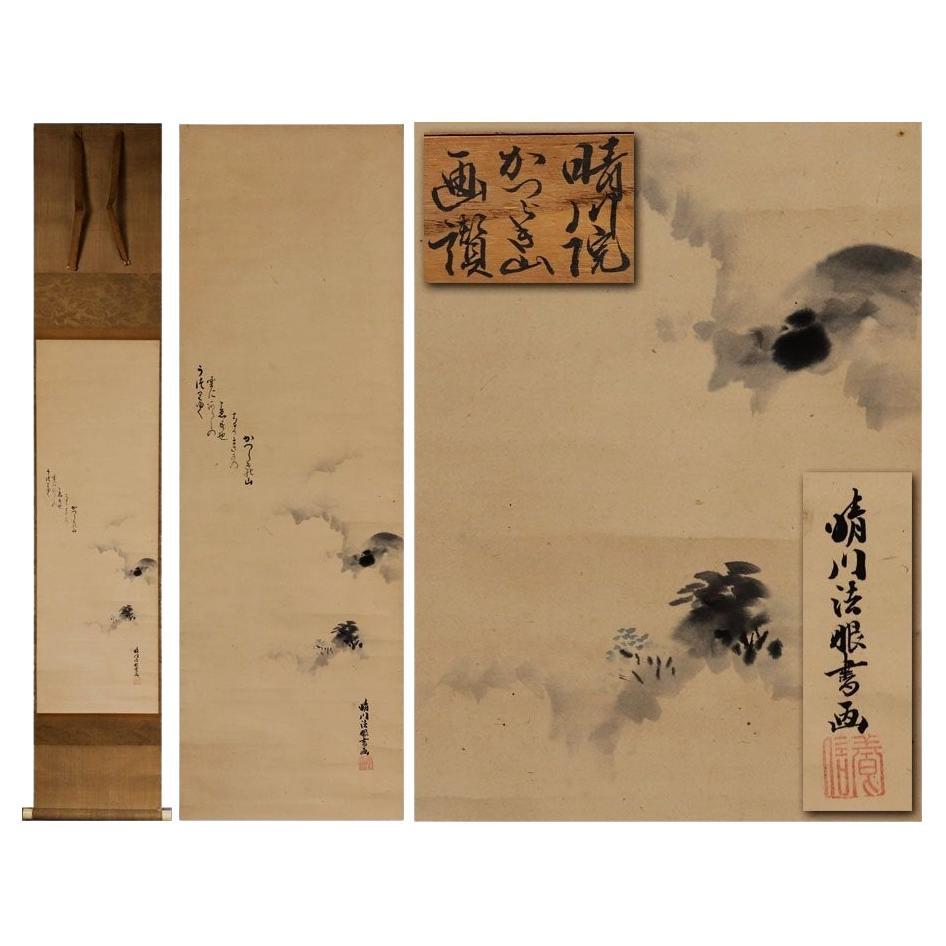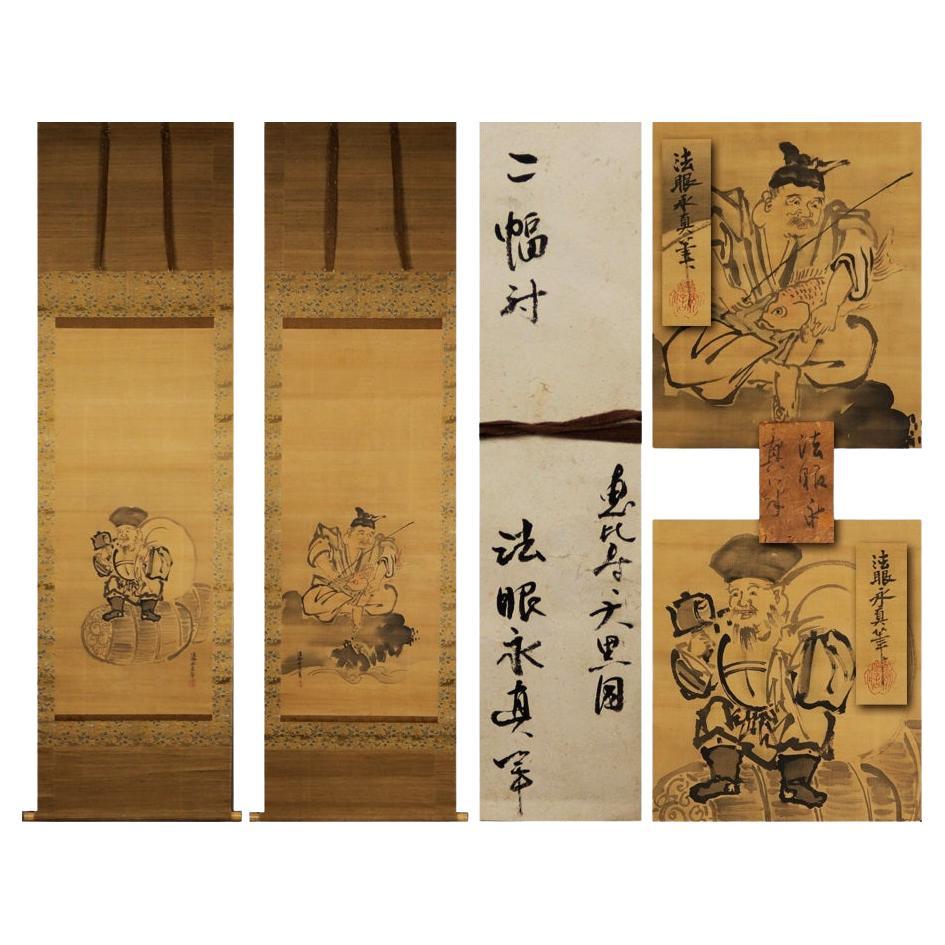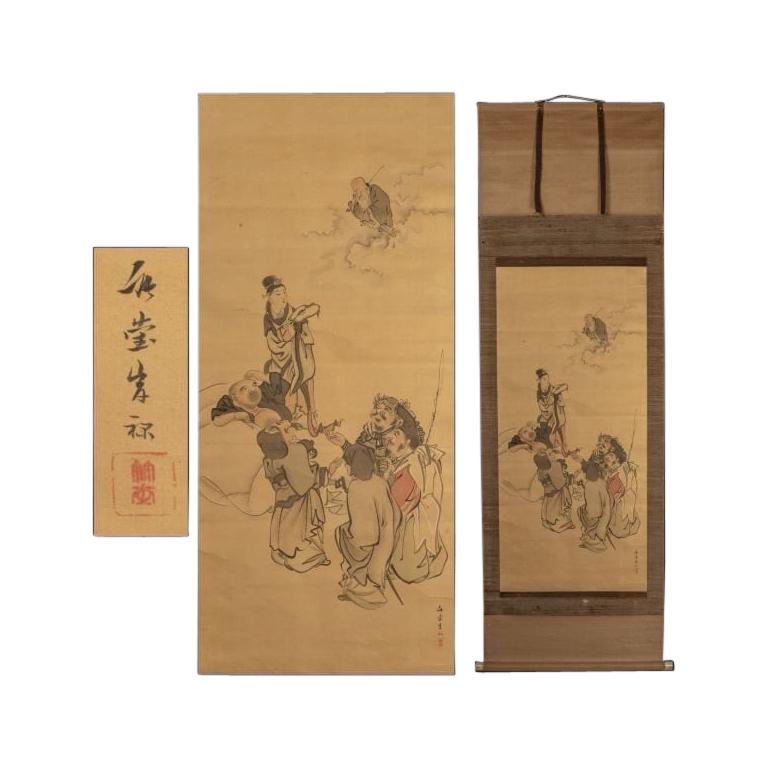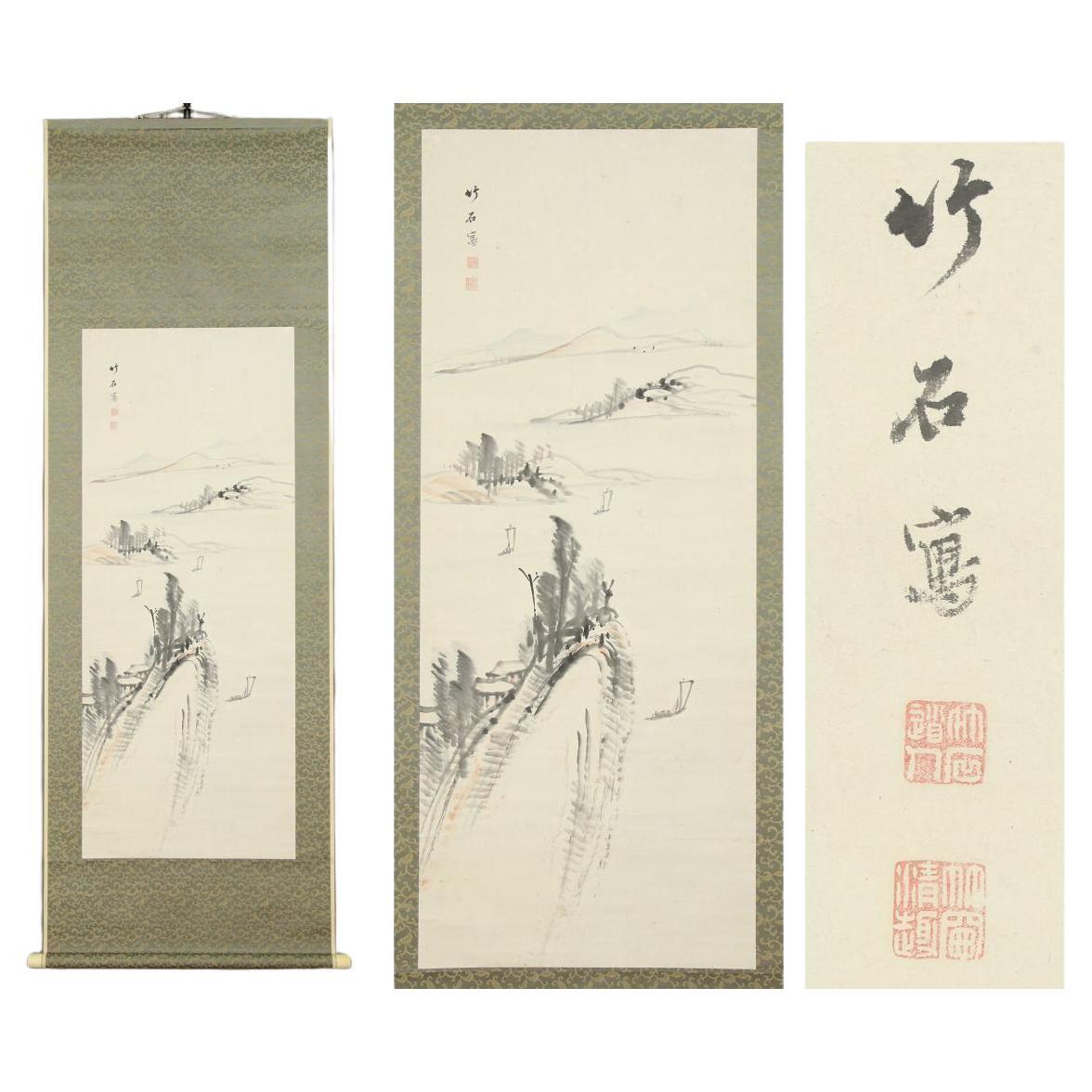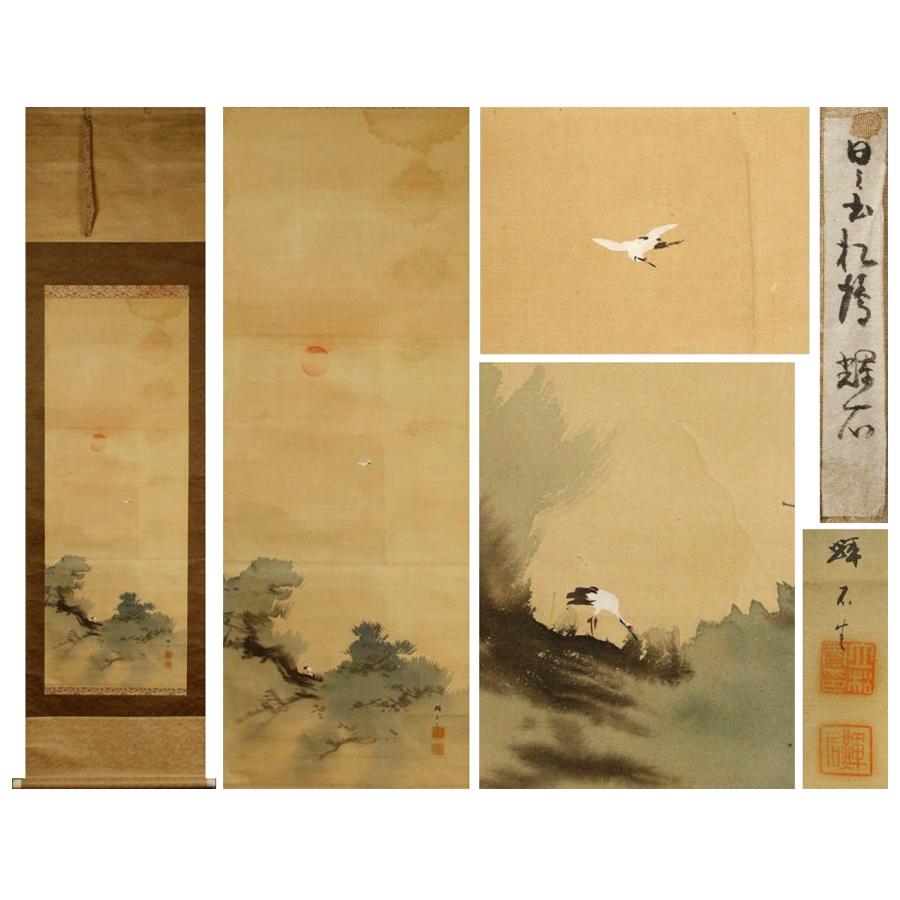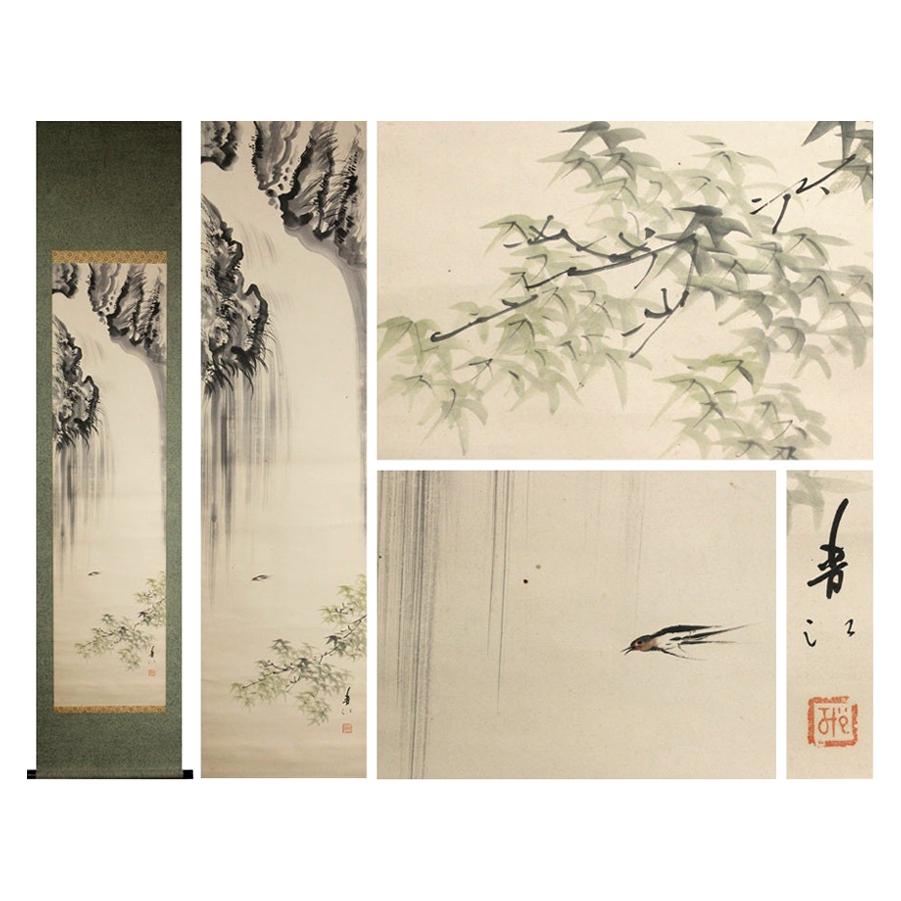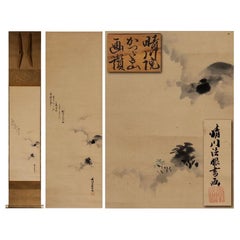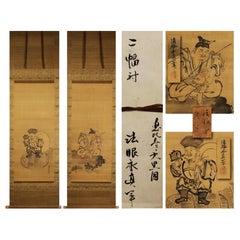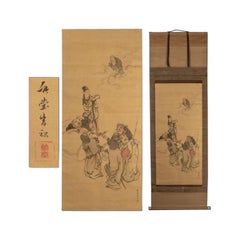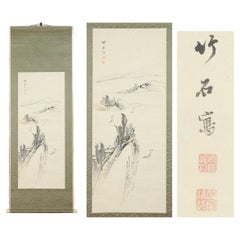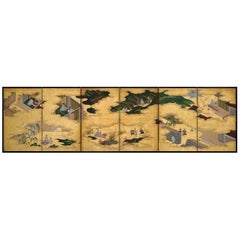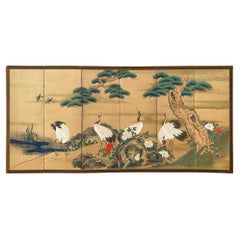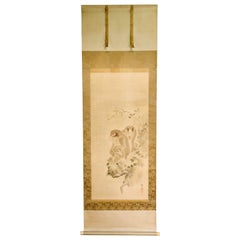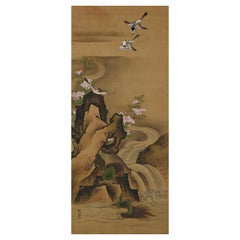Items Similar to Jurojin Flying Crane Scene Edo Period Scroll Japan 19c Artist Saeki Kishi Ganku
Want more images or videos?
Request additional images or videos from the seller
1 of 6
Jurojin Flying Crane Scene Edo Period Scroll Japan 19c Artist Saeki Kishi Ganku
$1,873.54
$2,341.9220% Off
£1,379.86
£1,724.8220% Off
€1,560
€1,95020% Off
CA$2,548.80
CA$3,18620% Off
A$2,832.28
A$3,540.3520% Off
CHF 1,484.15
CHF 1,855.1820% Off
MX$34,732.90
MX$43,416.1220% Off
NOK 18,929.42
NOK 23,661.7720% Off
SEK 17,808.10
SEK 22,260.1320% Off
DKK 11,876.04
DKK 14,845.0520% Off
Shipping
Retrieving quote...The 1stDibs Promise:
Authenticity Guarantee,
Money-Back Guarantee,
24-Hour Cancellation
About the Item
As you can see, Saeki Kishi Ganku brush Jurojin Hizuru figure / with box.
It is a
work that goes well with the flying crane and the Jurojin looking up, giving a unique and mysterious taste.
«Saeki Kishi Ganku»
83 years old from
Ganku ?? (1749 – January 19, 1839), or more formally Kishi Ku, was a leading Japanese painter of Kyoto and founder of the Kishi school of painting. He is famous for his paintings of tigers.
Ganku was born in Kanazawa as Kishi Saeki, studied painting styles including those of Chinese painter Shen Nanpin (???) and the Maruyama-Shijo school, and arrived in Kyoto around 1780.
By the late 18th century, Ganku's paintings were appreciated by patrons that included the imperial family, leading to a position under Prince Arisugawa. His students included his son, Gantai ?? (1782–1865), son-in-law Ganryou ?? (1797–1852), adopted son Renzan ?? (1804–59), Yokoyama Kazan ???? (1784–1837), Shirai Kayou ???? (fl. ca 1840-60), and Kawamura Bumpou ???? (1779–1821). He was made honorary governor of Echizen (Echizen no kami, ???) toward the end of his life.
Ganku died on January 19, 1839, in Kyoto.
¦ Silk handpainting
¦ State
There are discolorations
¦ Shaft dimensions / approx. 177.0 cm x approx. 45.5 cm.
¦ Paper size / approx. 96.5 cm x approx. 36.5 cm.
¦ Signs / There are inscriptions and seals as you can see.
¦ Box / Box.
- Dimensions:Height: 69.69 in (177 cm)Width: 17.92 in (45.5 cm)Depth: 0.04 in (1 mm)
- Style:Edo (Of the Period)
- Materials and Techniques:
- Place of Origin:
- Period:
- Date of Manufacture:18th-19th Century
- Condition:Wear consistent with age and use. ■ State There are discolorations ■ Shaft dimensions / approx. 177.0 cm x approx. 45.5 cm. ■ Paper size / approx. 96.5 cm x approx. 36.5 cm. ■ Signs / There are inscriptions and seals as you can see. ■ Box / Box.
- Seller Location:Amsterdam, NL
- Reference Number:Seller: 1330917030031stDibs: LU4863223179932
About the Seller
5.0
Platinum Seller
Premium sellers with a 4.7+ rating and 24-hour response times
Established in 2015
1stDibs seller since 2019
264 sales on 1stDibs
Typical response time: 2 hours
- ShippingRetrieving quote...Shipping from: Amsterdam, Netherlands
- Return Policy
Authenticity Guarantee
In the unlikely event there’s an issue with an item’s authenticity, contact us within 1 year for a full refund. DetailsMoney-Back Guarantee
If your item is not as described, is damaged in transit, or does not arrive, contact us within 7 days for a full refund. Details24-Hour Cancellation
You have a 24-hour grace period in which to reconsider your purchase, with no questions asked.Vetted Professional Sellers
Our world-class sellers must adhere to strict standards for service and quality, maintaining the integrity of our listings.Price-Match Guarantee
If you find that a seller listed the same item for a lower price elsewhere, we’ll match it.Trusted Global Delivery
Our best-in-class carrier network provides specialized shipping options worldwide, including custom delivery.More From This Seller
View AllLovely Japanese 18/19th c Edo Scroll Kano Osanobu Nihonga Painting Mountain
Located in Amsterdam, Noord Holland
Kano Osanobu (狩野養信)
Osanobu Kano (born August 18, 1796; died June 12, 1846) was the ninth painter of the Kobikicho Kano School in the Edo period. His common name was Shozaburo. His father was Naganobu KANO, and Tadanobu KANO was his son. His Go (pen name) was Osanobu Seisenin, Kaishinsai, and Gyokusen.
Brief Personal History
He was born the eldest son of Naganobu ISENIN during the Edo period. He was first sent to serve at Edo Castle at the age of 15, and it appears that he was apparently pushed by his father to perform various public tasks for the Kanon School. He kept a diary for 36 years, starting from the day before he first went into service at Edo Castle until the day before he died. The diary is entitles "Official Service Diary" (it consists of 52 volumes that are maintained at the Tokyo National Museum, and 4 volumes that are separately maintained at the different families), and have become the focus of a lot of attention in recent years for the detailed information they present on the daily life and work of a prestigious official painter. The reading of the characters of his name was originally "Takenobu"; however, with the birth of the first son of the Shongun Ieyoshi TOKUGAWA in 1813, whose name was Takechiyo, having a sylable with the same pronunciation of "Take"was deemed to be inappropriate, and was therefore changed to "Osanobu". Because Takenobu died the following year, after which he was referred to as Gyokujuin, Osanobu changed his pen name Gyokusen he had used until that point to Seisenin, in order to avoid using the same Chinese charcter pronounced alike. In 1819, he attained the second highest rank for a Buddhist priest, Hogen, and assumed the role of head of the family after his father passed away in 1828. In 1834 he attained the highest rank for a Buddhist priest, Hoin. He oversaw the rennovation of the wall paintings of Nishinomaru Palace of Edo Castle from 1838 to 1839, and Honmaru Palace of it from 1844 to 1846. It is thought that Osanobu later died due to the fatigue...
Category
Antique 18th Century Edo Paintings
Materials
Silk
$1,727 Sale Price
20% Off
Antique Japanese 17th c Edo Scroll Kano Yosanobu Buddhist Painting
Located in Amsterdam, Noord Holland
Eishin Kano's Ebisu/Great Country Map, double-width/comes with an old box.
The auspicious statues of Ebisu and Daikoku are standing in a double-width hanging scroll with a smiling fa...
Category
Antique 18th Century Edo Paintings
Materials
Silk
$3,456 Sale Price
20% Off
Lovely Japanese 18th-19th Century Edo or Meiji Scroll Painting Seven Lucky God
Located in Amsterdam, Noord Holland
Interesting and finely painted Japanese painting.
Provenance: From an old family from Kyoto.
width of about 62.0 cm axial destination width of about 67.8 cm × length of about 1...
Category
20th Century Japanese Meiji Paintings and Screens
Materials
Bronze
$1,345 Sale Price
20% Off
Japanese Painting 18c Edo Scroll Chikuseki Nagamachi Nihonga Landscape Painting
Located in Amsterdam, Noord Holland
[Authentic Artwork] ◆ Nagamachi Chikuseki ◆ Landscape ◆ Edo Period ◆ Mitsuishi Origin ◆ Kagawa Prefecture ◆ Handwritten ◆ Paperback ◆ Hanging Scroll ◆ k891 ◆ Nagamachi Chikuseki
Explore the artistry of Chikuseki Nagamachi...
Category
Antique 18th Century Edo Paintings
Materials
Silk
$1,823 Sale Price
20% Off
Lovely 19th Century Scroll Paintings Japan Artist Signed Crane in Landscape
Located in Amsterdam, Noord Holland
Artist: Tatematsu kiseki
Born in the forest home of Nagoya gun-cho, it inherits the later Tatematsu house.
Learn to Okumura Ishiran. Later the director of Seiho meeting was studied with Kono Bairei-Seiho Takeuchi...
Category
Antique 19th Century Japanese Meiji Paintings and Screens
Materials
Fabric
$1,104 Sale Price
20% Off
Waterfall and Bird Scene Meiji Period Scroll Japan 19c Artist Marked
Located in Amsterdam, Noord Holland
As you can see, this is a Japanese painting by Aoe,
which depicts the beautiful "Aoba Takiyanzu" with beautiful fresh greenery.
¦ Paper books and handwriting.
¦
There are some...
Category
Antique Mid-19th Century Japanese Meiji Paintings and Screens
Materials
Silk
$1,200 Sale Price
20% Off
You May Also Like
Japanese Screen Painting, Circa 1700 'Tales of Ise' by Tosa Mitsusuke
By Tosa Mitsusuke 1
Located in Kyoto, JP
A six-fold Japanese screen by Tosa Mitsusuke (1675-1710), Japan 17th-18th century, Edo period.
The signature reads Shoroku-i ge Tosa sa Konoe Shogen Mit...
Category
Antique Late 17th Century Japanese Edo Paintings and Screens
Materials
Gold Leaf
Serene Cranes: Late Edo Masterpiece
Located in Fukuoka, JP
Serene Cranes: Late Edo Masterpiece
Dimensions: 364x173 cm (143x68 inches)
Period: Late Edo
SKU: PTA154
Immerse yourself in a realm of timeless elegance with our latest addition—a ...
Category
Antique Mid-19th Century Japanese Edo Paintings and Screens
Materials
Wood, Paper
Japanese Silk Scroll Painting of Moneys Edo Period Mori Tetsuzan
Located in Atlanta, GA
A Japanese mounted vertical hanging scroll painting by Mori Tetsuzan (Japanese, 1775-1841) circa 19th century Edo period. The watercolor and ink on silk ...
Category
Antique 19th Century Japanese Japonisme Paintings and Screens
Materials
Silk, Paper
19th Century Japanese Silk Painting by Kano Chikanobu, Turtles & Azalea
Located in Kyoto, JP
Birds & flowers of the seasons
Pheasants & plum in snow
Unframed painting. Ink, pigment and gofun on silk
Kano Chikanobu 1819-1888
Signature...
Category
Antique Mid-19th Century Asian Edo Paintings and Screens
Materials
Silk
Japanese Two Panel Screen Manchurian Crane and Turtles
Located in Hudson, NY
In Japan, cranes symbolize fidelity as they mate for life and turtles symbolize longevity. Additionally, this screen also has the Japanese motif of sho-chiku-bai, or the three friends of winter (pine, plum, and bamboo). So called the three friends of winter because all three flourish during the cold months. This screen was originally fusuma doors...
Category
Antique Mid-19th Century Japanese Edo Paintings and Screens
Materials
Paper
Japanese Edo Two Panel Screen Meandering Stream with Birds
Located in Rio Vista, CA
Weathered Japanese late 18th century Edo period two-panel byobu screen depicting a meandering stream with sparrows in flight. Crafted with natural ink and color pigments on mulberry ...
Category
Antique 18th Century Japanese Edo Paintings and Screens
Materials
Brass
More Ways To Browse
Edo Period Japanese Painting
Japanese Crane
Asian Cranes
Japanese Paper Scroll
Japanese Crane Art
Silk Japanese Scrolls
Japanese Art Of Cranes
Japanese Edo Period Screens
19th Century Chinese School
Japanese Scroll Box
Japanese Tiger
Japanese Screen Kyoto
Edo Scroll
18th Century Japanned Box
Chinese Silk Scroll
Flying Cranes
Kyoto Screens
Japanese Brush Painting
